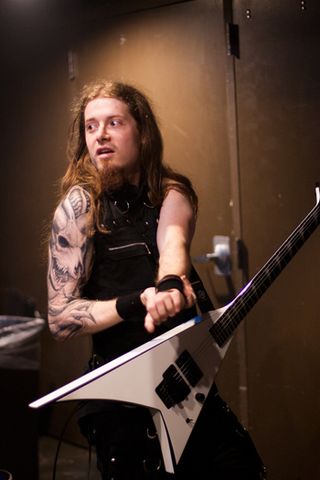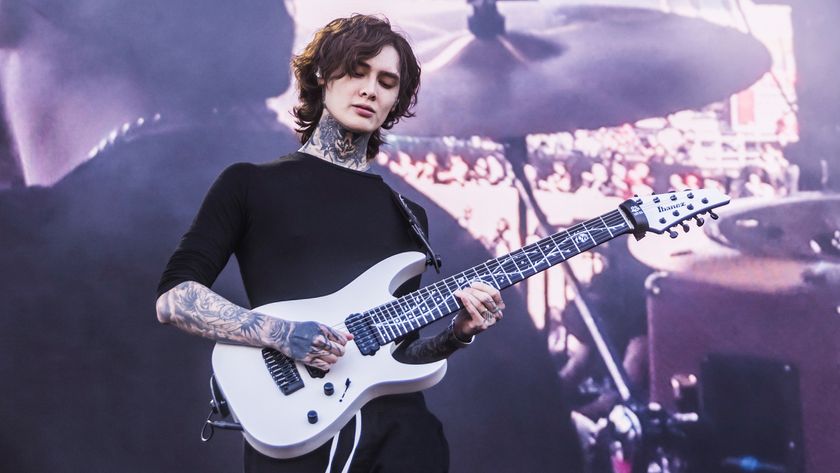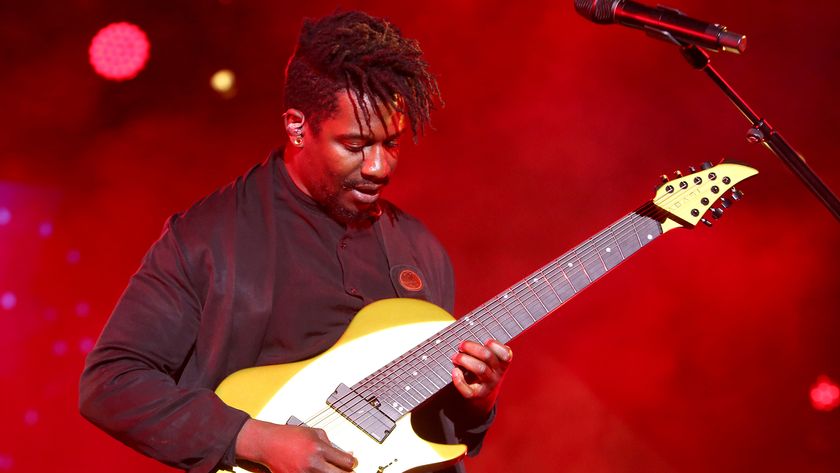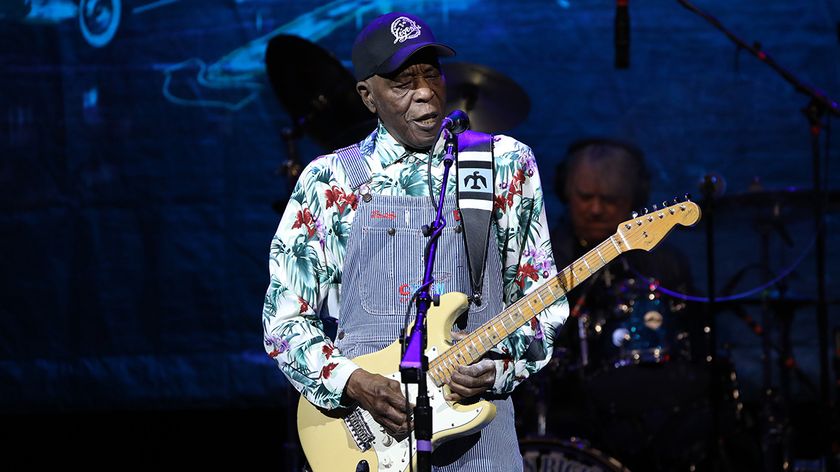Pagan Metal Roundup: Blackguard


When the popular Paganfest II tour rolled through New York last spring, featuring Korpiklaani, Moonsorrow, Blackguard, Swashbuckle and more, we caught up with Canadian pagan metal band Blackguard.
Here, Blackguard guitarists Kim Gosselin and Terry Roadcase weigh in on their place within the Canadian pagan metal scene, discuss their love of Jason Becker and Marty Friedman and deliver a succinct breakdown of the different pagan metal styles.
By Brad Angle. Main photos (and following gallery) by Sarah Sturges.
This tour is called “Paganfest.” What exactly is pagan metal?
GOSSELIN The real meaning of traditional pagan metal is to integrate at least one folkloric element into the music, even if it’s a keyboard. Thus the traditional instruments add a more “medieval” atmosphere to the music and lyrics. If many folkloric instruments are used together and they are the main part of the music, then we say it’s “folk metal." But, if you have the same example with pagan themes and lyrics, we'll say it’s “pagan metal."
Pagan Metal is a subgenre of the heavy metal music that makes a fusion between the extreme metal with pre-Christian spiritual traditions of Europe. The paganism is by extension a term for polytheistic traditions or worldwide folk religions outside of the Abrahamic monotheistic group of Judaism, Christianity, and Islam. If we take a look into the New Testament, historically the word “proselyte” denoted a person who had converted to Judaism, it can also mean the act of converting people to your own beliefs or point of view. So, most of the pagan religions are similar to other variants of Christianity, just like Jehovah's Witnesses, The Church of Jesus Christ of Latter-day Saints, Southern Baptist Convention while incorporating totally different non-Christianity belief systems including Eastern philosophies, Native American religions and all other mythologies.
In the case of the Paganfest, most of the bands are closely related to folk, vicking and pirate themes. Many of the bands are specially oriented towards the “Norse” or Scandinavian mythology, which comprises the myths of North Germanic pre-Christian religion. That, I'd say, is the main the “Pagan” element of the Paganfest tour. Norse mythology is the best-preserved version of wider Germanic paganism, which most of the written sources for that Scandinavian mythology were assembled in medieval Iceland in Old Norse.
Here is an important fact to remember; a religion is a strong belief in a supernatural power or powers that control human destiny, while a myth is a traditional story accepted as history to explain the world view of a people. There is no worship of God in the Norse belief system. Usually people who don’t really know much about paganism think it’s just related to Satanism or obscure religions.
Get The Pick Newsletter
All the latest guitar news, interviews, lessons, reviews, deals and more, direct to your inbox!
I mean if you take a look at the flyers you see bunch of skulls with medieval weapons, which seems to be influenced by something violent (just like black metal), but actually most of the pagan metal is totally the opposite way. Musically, it’s mostly very melodic, powerful and positive. I'd say the best description I can give you is party music and sing-alongs.

How did Pagan Metal come about? Who were the bands that started it?
GOSSELIN I guess that pagan metal was born a few years ago with the Swedish band Bathory, around the album Blood Fire Death. That was right before the folk metal style appeared. That album was in line with the black metal sound, but it also contained epic lyrics and themes (that were generally about the great northern wars). Then they released two other albums, Hammerheart and Twilight of the Gods, which were probably Bathory's most important records and the ones that defined the pagan metal style. The songs were mostly slow in tempo, and included omnipresent melodies and lyrics referring to the pagan themes. Then from that, a lot of subgenres appeared, like the pagan black metal, folk metal, vicking metal, heathen metal, battle metal and Celtic metal.
What are the key elements that make a band fit in the Pagan Metal genre?
GOSSELIN As I mentioned before, pagan metal is a much extended style, so the best I can do is offer a short description for all the related subgenres.
- Pagan Black Metal
- This is the classical sound of pagan metal. It must have a typical black metal vocal, but the tempo is faster and the production is very low-fi. There are also few bands doing this type of music without any folk elements. The unifying element is the lyrics, which must be related to pagan themes such as battle, nature, legend and mythology. Here are few bands who did pagan black metal albums; Abigor, Windir, Kampfar, Temnozor, Theudo, Skyforger and Himinbjorg.
• Pagan Folk Metal
This is also in the vein of the classical pagan black metal but it's way less violent. The main point is to employ real folk instruments, which gives this music its special sound. Here are some bands allied to that style: Korpiklanni, Asmegin, Folkearth, Hantaoma, Kroda Hel and Lumsk.
• Vicking Metal
This music may be similar to the above two (epic with growling vocals), except its lyrical themes are only related to Vicking ideology, battles or lifestyle. Here are some bands associated with that style: Amon Amarth, Einherjer, Ensiferum, Aegir, Equilibrium, Galar and Manegarm.
• Heathen Metal
This is a special genre because the vocals are mostly based on clean and melodic harmonies, and the lyrics refer to Nordic and German mythology and nature worship. Here are a few bands to check out: Falkenbach, Rivendell, Nydvind, Heidevolk, Odroerir, Tyr, Menhir.
• Battle Metal
Battle metal is a very young style and as such there are only few bands that currently play it: Moonsorrow (old albums), Bal Sagoth, Turisas and Thronar. The most important elements of this style are the battle lyrical element and orchestral instrument sections featuring trumpets, French horn, trombone and choir. More often than not the orchestral elements are played by a keyboard, and really give the songs an epic feel.
• Celtic Metal
True to its name, Celtic metal is very easy to identify because of its ubiquitous use of Celtic mythology in its lyrics. Many traditional Celtic folk instruments are unique to this style, including the tin whistle, mandolin, bagpipe and Bombard. Bands linked to this style include Aes Dana, Belenos, Tuatha De Danann, Waylander, Cruachan, Skyclad, Heol Telwen and Eluveitie.
As far as lyrics and themes are concerned, what are some pagan subjects that you explore in your music?
GOSSELIN Lyrically we share certain similar elements to other pagan bands, however paganism in general has never been our singer Paul [Ablaze's] focus. Our lyrics vary quite a bit, from the retelling of Quebec folk tales to battle-themed songs, but they don’t necessarily cater to any overriding pagan theme.
You guys used to be called Profugus Mortis. Why did you change the name to Blackguard?
GOSSELIN We had wanted to change the name before the release of our first record, So it Begins (Prodisk/Profusion), because we felt the name Profugus Mortis didn’t represent us anymore. When the band started in 2001 it was far more on the black metal side, and the name represented that. But now we have far more of power/folk metal influence. In the end we couldn’t agree on a name so we kept P.M. When we started talking with Nuclear Blast they asked us if we’d be willing to change names because apparently there were already a few bands with very similar names. So we jumped at the opportunity...and now we’re Blackguard!
What made you first pick up a guitar?
GOSSELIN As far as I can remember, in 1991 when I was 12 my sister got a new boyfriend. He was always listening to some old trash/glam metal into his car. One day he gives me a ride into his car, and there was a song from Testament's Practice What You Preach playing. I asked what the high-pitch instrument was playing that sounded like a Japanese Manga. He told me it was a guitar, and I instantly fell in love with that sound. The week after I was playing my first notes on an old crappy classical guitar.
What metal guitarist most influenced your style?
GOSSELIN Back in the day, when I was in high school, I listened to my Megadeth Rust In Peace album so many times that I was able to learn all the songs. I was impressed by the work of Marty Friedman because he got such a unique sound and played in uncommon scales. Then I discovered Cacophony Speed Metal Symphony by Marty Friedman and Jason Becker and that was it. I was completely amazed by the work of those two prodigies. I have listened to that cassette so many times that I burnt out the ribbon. Then I bought Marty Friedman's Dragon Kiss and Jason Becker's Perpetual Burn albums, and I couldn’t stop listening to them either.
Were you inspired by any other non-metal influences?
GOSSELIN Nintendo music influenced my playing style and composition a lot. I still listen to the music of some of the greatest vintage Nintendo games like Ninja Gaiden, Double Dragon, Castlevania and many more. Usually people get very quickly annoyed by those type of sounds, but I’m pretty sure those Japanese composers were influenced by early Eighties heavy metal.
Canada isn’t immediately known for its pagan culture. What makes the Canadian pagan culture unique?
GOSSELIN Canada has tons of myths and legends surrounding its own folklore. They are mostly based on nature and we have few of them telling stories about ghosts and fairies. They have been shared in the oral tradition for many years, but now we have a lot of books related them. They are unique to our culture because the animals in the stories are unique to our country. They also tell us history of a particular area of the country and the way that life used to be for those people.
As a player, what technical requirements are needed to make this music?
GOSSELIN We are used to playing our songs with very fast tempo, so I have to practice a lot with a metronome. We also play our songs with a playback track for the orchestration part, so our drummer has to listen to a click track while she’s playing. The most important part is our stage presence, which is why we rehearse three times a week. We want to make sure our headbanging is kick ass.
TERRY ROADCASE Our live show is a big part of what Blackguard is all about. In order to excel in this kind of music, you have to deliver an amazing live show. So you need to be very comfortable with headbanging and moving around a stage while shredding on your guitar! Anybody can make a miracle in studio, but live, this is where you really see what a band is about.
What guitar technique/approach makes you stand out from the pack?
GOSSELIN I always have been fascinated by the sweep picking of Jason Becker, so I began to explore some simliar techniques. I do two-string arpeggio techniques on a “Humpaa” beat with an accordion accompaniment to give it a powerful folk feeling. I also employ a lot of pentatonic-based, three-notes-per-string stuff. Using different scales in the same solo is another important thing. I'll do a very fast shred through harmonic minor, and add some of the Hirojoshi scale to it to keep the listener entertained.
Please explain your axe of choice, and why it's right for your sound?
GOSSELIN I’ve been playing a Jackson since I was about 12, and I honestly haven’t played a better guitar since. We were fortunate enough to get a Jackson endorsement, which I a dream come true. My Jackson Kelly has a unique tone and sustain because of his shape: it looks like a Gibson Explorer, but the angles are sharper. It’s also easier to play high up the neck because there’s a lot of space. The neck is also the thinnest I ever tried on a Jackson, which also makes it very easy to play. I changed the pickups for an EMG 81 and 85 humbucker, just like Zakk Wylde. I like the high output because it give me more sustain while I’m doing solos. There is also a “rail magnet” in these pickups that gives a much smoother sound instead of usual ceramic pickups. I’m also using .010 – .052 gauge strings.
We've recently been endorsed by ENGL, and I can tell you they make some kick-ass amplifiers. I bought the Invader 150 which is very badass, because of its six EL34 tubes and four independent channels. Each channel has three-band passive EQ, powered by four ECC 83 tubes. We also have Vader Cabinet endorsement. Those cabs are extremely powerful and have punchy bass, mellow mids and smooth highs. Plus they're like impossible to destroy.
ROADCASE I play with a Jackson MG RR24. It's a neck-thru guitar with the Randy Rhoads shape, loaded with one EMG 81 pickup and a killswitch. The next step would probably be a custom shop guitar from Jackson! It's only a matter of time...
What piece of gear is vital to your sound?
GOSSELIN The guitar is the most important element for the sound because everything starts from it. It’s also very vital to be in symbiosis with the instrument: you have to be one with the guitar if you want to give the best performance. I usually go on the stage and I can’t hear myself playing, but I know I’m playing the right notes because I can feel it on the neck the same way I did in rehearsal.
ROADCASE Like Kim said, the guitar is very important. But what's in your rig also makes a big difference. You could have the best guitar and amp ever, but without a noise gate, delay and such, your live sound wouldn't be the same at all.
What is the typical pagan metal fan base like? Is it full of role-playing, Dungeons and Dragons fans?
GOSSELIN As far as I know it’s a very wide range of people. I don’t think they all play to those Dungeons and Dragons games. They're mostly a bunch of people that love melodic metal, partying and having fun.
How far do the pagan lifestyle and ideals extend into your daily life?
GOSSELIN I don’t think I’m pagan at all, but like everybody I’m trying to preserve nature by recycling at home. I’m not worshiping any entities, I just believe in myself and I’m trying to do the best I can for other people.
Where do you see the pagan metal movemnt heading from here?
GOSSELIN That movement has been popular for many years in Europe. In America it’s growing. We've been seeing more and more kids with t-shirts from bands like Ensiferum, Finntroll and Korpiklanni. So I’m pretty sure it’s only a matter of time before this metal style becomes very popular in North America.






Brad is a Brooklyn-based writer, editor and video producer. He is the former content director of Revolver magazine and executive editor of Guitar World. His work has appeared in Vice, Guitar Aficionado, Inked and more. He’s also a die-hard Les Paul player who wishes he never sold his 1987 Marshall Silver Jubilee half stack.

“I walk in and Hans has me sit down. And he goes, ‘Let’s just get down to business. I’ve been thinking about you a lot lately’”: After his spiritual awakening, Tim Henson is ready for anything – heavy Polyphia, trippy solo records and A-list film collabs

“There’s amazing players like Josh Smith and Eric Gales, and I thought, ‘OK, I’ve been missing out. I’m learning the blues’”: Tosin Abasi said he wanted to release a blues album – is it still on the cards?
Most Popular









